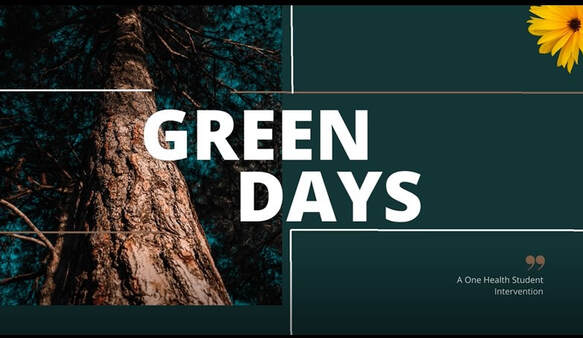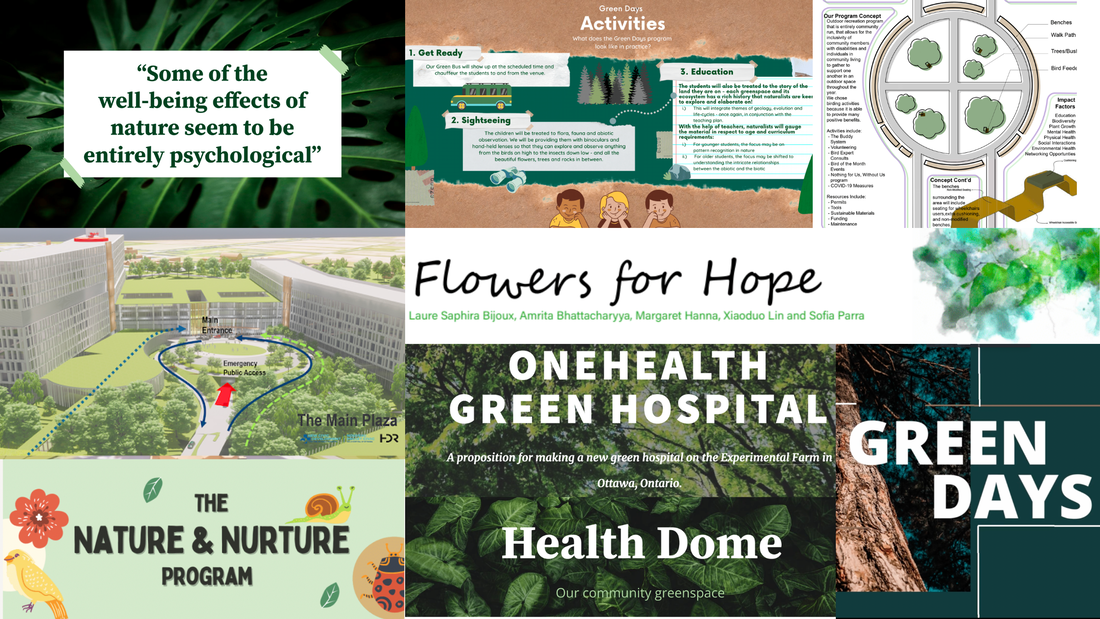|
by Lilo Noort, CHAIM Centre Communications Intern  A thrilling six weeks came to an end this past Saturday, as the 2022 One Health Challenge concluded. The One Health Challenge is a systems-based approach that brings together human, animal, and environmental health to create an interdisciplinary approach to guide strategies for global health issues. Back in January, Carleton undergraduate students were asked to consider the need for outdoor green spaces highlighted by the COVID-19 pandemic. Over 30 students from a range of disciplines, including Industrial Design, Neuroscience, Engineering, Environmental Science (and more!) formed interdisciplinary groups. Teams were led by a graduate mentor also from different faculties and were each given the task of creating an intervention that promotes the use of green spaces to achieve public health benefits while balancing the potential negative effects on ecological health and biodiversity. Once they were introduced to the Challenge, they had the opportunity to work with a Facilitator from IBM specializing in design thinking and problem definition for the first two weeks of the Challenge. Throughout the Challenge the students collaborated with their mentor to narrow their scope and consider the various perspectives of the One Health approach as they developed their intervention. They were supported by background information on the topic and also allowed to branch out to find different resources that would inform a product that showcased their expertise, creativity, and out-of-the-box thinking. Student groups were then tasked with recording a 3-minute video pitch outlining their intervention in an engaging way for judges and audience members, and also supporting documentation for the judges. The Final Event on March 19th began with introductions from the Director of the Centre, Dr. Kim Matheson, who provided a recap of the Challenge and thanked teams and mentors for their hard work over the last six weeks. This year, the event was introduced in partnership with the IBM Center for Advanced Studies and featured community experts from Ottawa Public Health, IBM, and The Delphi Group forming the judging panel. The videos were played for the judges and the Carleton community members on the call who got to see a broad range of solutions surrounding greenspaces from physical spaces to community-based programs. Click here to see all of the 2022 OHC Team’s video pitches! After the initiatives were presented, judges met with teams, to ask questions about their projects and learn more about their rationale and approach. While the judges deliberated, the audience was invited to a screening of a TEDx talk on Urban Green Spaces by Jessica Pendergrass. The Challenge concluded when the judges announced the winning team: 'Green Days' made up of undergraduate students Malik Sylla, Veronica Yung, Ericka Uzoegwu, and Frank Li who were led by graduate mentor Sebastian Steven. Runner-ups were the ‘Community Flyers’ Team and the ‘Flowers for Hope’ Team. The winning team of the 2022 Challenge will receive a $100 cash prize and the chance to present their intervention at Carleton's annual Life Sciences Day 5.0 on May 10th, 2022 on Healthy Communities! The judges were impressed with the dedication and creativity from the student projects and are following up with the students teams to build on these ideas and to hopefully make them a reality. The CHAIM Centre’s OHC Team is immensely proud of the hard work and commitment from all the student participants and graduate mentors throughout the 2022 OHC Student Challenge. Congratulations to all!
0 Comments
By Tariro Hlahla, Carleton Neuroscience Student  “Regardless of ethnic background, there is no denying the universal black experience,” writes Health Sciences student Wiza Mkandawire. “This time is paramount to refuel and rejuvenate ourselves, reminding ourselves why exactly it is all worth it.” Similar notions were mirrored in other comments from students - Black History Month is a time to celebrate black people’s achievements. These achievements are nothing short of exceptional, not only historically but in modern times. From the monumental creations in science like the invention of the blood bank by Charles R. Drew to the immense contributions to art and pop culture such as the 2022 Super Bowl Halftime Show being composed primarily of Black music legends like Mary J. Blige and Kendrick Lamar, it’s clear that many Black people have been and continue to be front and centre on the world stage. Yet the Black community continues to face turmoil and oppression. Besides the 2020 George Floyd protests that come to mind, Black people suffer relentless setbacks in almost every aspect of their lives: concrete ceilings and glass cliffs, the harmful stereotype of the diversity hire, the cruel judgement of Black skin colour and hair texture, and so much more. One thing that direly needs to be addressed is supporting Black communities throughout their educational journey, including during their postsecondary education. “[Being a black student] can also feel like being in a very violent struggle, especially when endeavouring to be at the forefront of university leadership and politics,” says Public Affairs and Policy Management student Nikayda Harris. “Having to fight for equal access and representation in residence, in our programs, in the literature and academic works we are exposed to and for our mental health, especially when considering the various traumas that we have faced and have inherited can be tormenting.” According to StatsCan, Black people make up 3.5% of the Canadian population. This means that from a young age, most Black children may not be able to find many Black peers. “I moved from Jamaica to Canada when I was eight years old, and that was already a difficult experience for me in terms of fitting in, as I had a strong accent and I looked and dressed differently,” writes Criminology student Zana Palomino. This sense of alienation can continue far into their academic careers. Just 2 years ago, scandal broke loose when a professor at a prominent Ottawa university used a racial slur that is considered extremely derogatory to Black people and was supported by several of their colleagues. Furthermore, stories have emerged about Canadian Black students being assaulted by police and campus security as a result of racial profiling. Black History Month celebrations within universities mean nothing without acknowledging the cracks in the system. When an entire group of people are not being uplifted by their peers, professors, or protectors, they are being set up for failure. This problem transcends university and spills out into other facets of these students' lives; for example, a Black individual will make on average $12,000 less than their white counterpart. This is an enormous discrepancy in a time when housing is at its least affordable and food prices continue to climb. Despite the copious numbers of setbacks, we have observed something magical begin to form: resilience. According to StatsCan, 44% of Black people believe they have the ability to bounce back from difficult periods in life as opposed to 33% reported in the rest of the population; we also see that almost two thirds of the Black population believe they always learn something from an aversive experience, whereas less than half of the rest of the population endorse this belief. Resilience is a key theme when you ask students about what Black History Month means to them. “[Black History Month to me is] people’s stories and experiences of how they overcame hardships and how they were able to implement change,” comments Biology student Nana Owusu. “Our ancestors have paved the way for us with their sacrifice, strength, courage, and authenticity.” says Health Sciences student Rougayyah Jalloh. Regardless of the struggles that these students must face, they are determined not only to weather the storm, but to come out of the other side stronger than ever. There is certainly much to learn from the Black students who will be among our future doctors, educators, policy makers and more. Resilience is instilled into every Black child from the time they are born to the time they make their way into the world. What non-Black communities must do in order to truly make a difference is to start listening to what Black people have to say. It’s not about creating your own ideas of what Black people need, it’s bringing Black folks into spaces where they can voice their concerns and feel comfortable articulating their unique life experiences. “[Black History Month is] a time to educate oneself on the rich history and is a call to action to continue to advocate for and uplift those within society who are often pushed to the sides,” Psychology student Ashley Igboanugo states. In a world where Black achievements are pushed to the side, stolen by others, downplayed and disregarded, we must take the first step to equity by giving minorities a platform to voice their opinions freely. We need to abolish the stereotypes of the angry ghetto black woman and the aggressive hypermasculine black man and start embracing every facet of Black humanity as it is: colourful, unique, diverse within itself and worthy of consideration. In the month of February, we ought to take time to reflect on the mistakes made and the deep flaws in our society while also rejoicing on the progress we have made. As student Nikayda eloquently states: “If we don’t uplift and honour ourselves and our ancestors, our souls die violent deaths. So until we can reach this promised land of milk, honey and abundant black joy, we take February and we love, we hope, and we remember.”
By Max Kabongo, Carleton Neuroscience Student  As a university student, you will be interacting with people from different cultures or situations. These factors result in a different lived experience than one in which you may be accustomed such as living with a mental illness or constantly being harassed due to racial prejudice. Recently, the case involving the murder of Ahmaud Arbery concluded with the convictions 3 white males for a racially charged hate crime. How do you feel? Thoughts may have gone through your mind such as anger as an innocent man was murdered for being Black. Perhaps you felt relief or happiness knowing that those who are responsible are facing life imprisonment and justice has been served. Without having known Ahmaud Arbery, you may be sharing emotions held by those he was close to; a phenomenon we describe as empathy. Empathy is the ability to share and understand the emotions of others (ex. “I feel what you feel”). It is important to be empathic as to show authenticity when communicating. But what is empathy? How does empathy emerge? Can we enhance it? What is empathy? At the most basic level, empathy is a complex process that seems critical for the formation and maintenance of social bonds. Indeed, understanding how others feel and being able to imagine how others are feeling (independent of our own feelings) may be a hard-wired mechanism to determine when others are in need of support. In short: Empathy helps us to coordinate our emotions and respond to them in others. The ability to do this varies. For instance, we expect greater empathy in those who work in shelters for the homeless, in people choosing to care for a sick relative, or those who are there for a friend after a tough break up. We also know there are individuals that have low levels of empathy, and these individuals appear less able to form social bonds, such as individuals with autism spectrum disorders (ASD). While this does not mean that these individuals do not form social bonds, they do have difficulties interacting socially and understanding that others have feelings different than their own. While many consider empathy a uniquely human trait, there is evidence that non-human animals also show at least some processes associated with empathy. These processes include emotional contagion, theory of mind, and experience/social learning. Emotional contagion (Emotional Empathy). Emotional empathy involves a sensitivity to the emotional state of others, and an awareness of how their emotions affect how we feel. In effect, emotional contagion involves recognizing a particular emotional state in another (i.e., fear, sadness, happiness, anger) and becoming “infected” by their emotional state. This more primitive aspect of empathy can be seen in many species of animals and in humans. For example, rats will show fear when observing a cage mate experience a stressor. Humans also respond to injustices with anger and actions such as ongoing protests in response to police brutality against black people. The capacity to experience emotional empathy in this form appears to be innate. Theory of mind (Cognitive Empathy). Cognitive empathy is the ability to understand that others may be feeling or thinking differently from us, and yet, we are capable of understanding the situation from their perspective. This is referred to as a theory of mind, which is related to perspective taking. For instance, humans are capable of detecting differences between what we think and what others believe our mental state to be. In this sense, the emotions we show to others may not reflect what we feel in order to be mindful of others’ emotions. While non-human animals display emotional empathy, it is more difficult to determine if they demonstrate theory of mind. However, some suggest that highly social animals like elephants, dolphins and chimpanzees are capable of such perspective taking.  Learning and Empathy. There are components of empathy that appear to be strengthened by experience. For instance, one may have emotional reactions to social issues like discrimination, social injustice or lack of access to health care, but the degree of empathy one has for those suffering may be enhanced by personal experience. A person that has been homeless in the past or knows someone close who is homeless, is much more likely to participate in caring for the homeless. Someone who has experienced high levels of pain may display more empathy for a movie character that is going through some traumatic physical experience despite the situation not being real. Thus, empathy can be elicited and enhanced by previous experiences.  So how do all of these aspects of empathy come together? Empathy in the brain Many brain regions are associated with empathy, including the paraventricular nucleus of the hypothalamus (PVN), a tiny cluster of cells located deep in the middle of the brain. The PVN secretes a hormone called oxytocin, which is thought to be involved in development and maintenance of social bonds and has stress buffering effects. A stressful experience will elicit among other things, the release of oxytocin, and event that may be related to the generation of social support. The effects of oxytocin, together with those of social support during a stressful event may be a critical biological signature of empathy. McQuaid (2015) found increased responsiveness to positive and negative interactions in university students carrying a certain gene polymorphism of the oxytocin receptor which has previously been associated with enhanced empathy. Another region implicated in empathy is the amygdala, a structure nested within the temporal lobe that is crucial for emotional processing, most notably in the context of fear, stress and anxiety. Stressful and traumatic experiences activate the amygdala, leading to a sequence of downstream events which ultimately lead to responses aimed at escaping a threat. Critically, activation of the amygdala leads to a learned association between the stimuli (the sounds, smells, sights) associated with the threat and the experience of the threat, so that these events can be predicted and avoided in the future. Unfortunately, overactivation of the amygdala leads to conditions in which this region becomes stimulated by cues that normally would not produce fear responses, such as anxiety or posttraumatic stress syndrome. This can occur when individuals observe traumatic events happening to others, such as with children in homes where a parent is physically or verbally abused, or when people witness a traumatic event (i.e. a traffic accident, terrorist attack, military combat) in which others are hurt or killed. The amygdala plays an important role in the production of emotional empathy, and in the mechanisms elicited in the face of fearful events. The anterior cingulate cortex (ACC) is a strip of tissue located at the front of the brain containing cells that are connected to several brain regions implicated in memory, emotion, and reward. Interestingly, scientists have discovered that this brain region responds to direct or observed experiences of pain or pleasure. In primates, a subset of cells within the ACC termed “mirror neurons” become activated when observing an experimenter eating a snack that the monkeys had tasted before. Further research on this population of cells suggests these may be implicated in the Theory of Mind: individuals on the Autism Spectrum (who often lack Theory of Mind) have less activation in this brain region when viewing facial images corresponding to different emotional states. Another a brain region called the frontotemporal junction seems to be critical for individuals to imagine themselves in someone else’s shoes. This region develops through childhood. Finally, the prefrontal cortex seems to play a role in human’s ability to understand that the behavior and feelings of others are independent of our own. These three cortical regions form a network that is critical for fully experiencing empathy. Empathy across the life span
How we react to the emotions of others changes throughout development. Evidence of emotional empathy begins to appear during infancy (e.g., when an infant cries while observing another infant crying, or displays facial mimicry). Within the 2-3 of years, a toddler shows more cognitive aspects of empathy such as expressing distress when observing a parent experiencing pain. A toddler’s response to another’s distress may be accompanied by prosocial behaviour such as comforting. These responses are the beginnings of cognitive empathy. Theory of mind begins to develop around the ages of 4-5 as children become aware that others have unique feelings, thoughts, and desires, and that other will respond to their actions when they are happy or displeased. Neurodevelopmental and genetic factors, as well as familial relationships influence how empathy develops across the lifespan. As the brain matures, so does our understanding of the emotions and intentions of others. Unfortunately, in older adult years, those brain regions important for empathy begin to deteriorate. While this does not necessarily produce impairments in understanding the emotions of others, it may produce cognitive alterations that decrease the ability to interpret the motives of others (cognitive perspective-taking), and this has been linked to the increased vulnerability of older adults to being exploited or taken advantage of, for example susceptibility to scamming. Can we enhance empathy? Forming strong social connections allow us to better communicate how we feel. Empathizing with others places a critical role in this process, as it allows us to understand the desires and problems of those around us and to act accordingly. The human brain has been shaped to function in a social context and providing a rich social environment will maintain the cognitive processes that allow for empathy Empathy develops with age and is shaped by our experiences either directly or vicariously. This also entails those emotions and actions of others are addressed as we show support through listening; even to differing opinions or beliefs. It is easier to empathize with those we are close to, such as friends and family. But by informing ourselves of the experiences of others, we can begin to see things from a different perspective. Furthermore, understanding the importance of empathy helps us communicate with others, especially on a university campus. We are currently seeking a a part-time Communications Intern to support our knowledge translation activities and manage our web presence over the summer! Check out the poster below for more details! Carleton students with journalism and social media expertise are encouraged to apply.
Candidates can send their CV and covering details to chaimcentre@carleton.ca. |
Archives
March 2023
Categories
All
|










 RSS Feed
RSS Feed